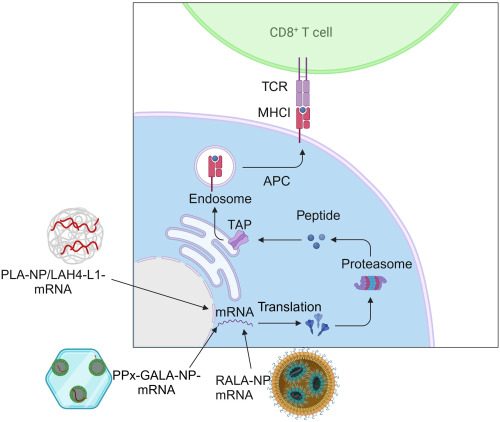
### A Fresh Hydrophobic Tag Facilitates High-Purity Production of Essential RNA Intermediates
#### Introduction:
Recent breakthroughs in the realm of chemically synthesized RNA present significant opportunities for transforming the landscape of RNA-based therapies, including *mRNA vaccines* and *gene therapies*. Scientists at Nagoya University, Japan, have pioneered a novel technique utilizing a hydrophobic tag that significantly enhances the purification process of crucial intermediates during RNA chemical synthesis. This innovation permits the production of 5′-monophosphate RNA with high purity, essential for capped messenger RNA (mRNA) and circular RNA (circRNA) in therapeutic applications.
The newly developed method not only provides a more affordable and efficient alternative to standard in vitro transcription-based RNA production but also paves the way for expedited and scalable mRNA synthesis. These developments could have extensive implications, particularly in vaccine creation and personalized medicine.
#### Context: mRNA Synthesis in Therapeutics
The significance of RNA in therapeutic use has surged over recent years. Prominent among its applications are *mRNA vaccines*, such as those developed against COVID-19. Beyond vaccines, RNA therapies promise a broad spectrum of medical interventions, ranging from cancer immunotherapy and gene replacement therapies to tackling protein deficiencies caused by genetic conditions.
##### Traditional RNA Production Challenges
Traditionally, RNA synthesis has involved enzymatic methods, primarily *in vitro transcription* (IVT). Although these methods are effective, IVT comes with multiple manufacturing hurdles, including yield, purity, and time constraints. Conventional IVT generates two main by-products: 5′-monophosphate (vital for capped mRNA production) and 5′-triphosphate RNA. The latter is particularly problematic as it can provoke immune responses and disrupt subsequent processing steps.
Effectively separating these by-products is a crucial yet challenging aspect of RNA manufacturing, contributing to the elevated costs and complexities of creating mRNA for therapeutic purposes.
In contrast, chemical RNA synthesis presents a compelling alternative, allowing for precise control and significantly quicker processes by eliminating the need for a DNA template, which can take up to a month to synthesize enzymatically.
#### Breakthrough: The Hydrophobic Tag Technology
To tackle the separation issues associated with RNA synthesis, **Hiroshi Abe** and his team at Nagoya University have created an innovative phosphorylation reagent featuring a hydrophobic tag. This tag improves the purity of 5′-monophosphorylated RNA by simplifying its separation from 5′-triphosphorylated RNA during chemical synthesis.
Following thorough evaluations of various candidates, the researchers opted for a *nitrobenzyl derivative* with a **tert-butyl group**. The addition of this hydrophobic tag alters the chemical characteristics of the RNA, facilitating the easier removal of undesirable by-products. Once the targeted 5′-monophosphate RNA is extracted, the hydrophobic tag can be eliminated under mild conditions, such as exposure to UV light or reductive treatments. This method streamlines and enhances the entire RNA synthesis workflow.
“RNA is inherently unstable,” Abe notes, “and earlier separation methods often necessitated harsh chemical environments that compromised the RNA. The unique aspect of our hydrophobic tag system is that it utilizes gentle deprotection conditions, thus safeguarding the RNA’s integrity.”
This technique effectively alleviates a key bottleneck in chemical RNA synthesis: the purification of high-purity intermediates.
#### Demonstrating the Practical Potential: HiBiT Protein mRNA
To validate the practical applicability of their technique, Abe’s team synthesized an mRNA encoding the HiBiT protein, a well-known molecular reporter. They implemented their hydrophobic tag system to create a 68-nucleotide mRNA entirely via *chemical synthesis*, subsequently removing the tag and chemically capping the mRNA.
The outcomes were encouraging. The researchers observed that their chemically synthesized mRNA exhibited sequence uniformity, preventing the tail-length variability typically seen in IVT-based synthesis. This distinction is crucial, as variations in RNA length can result in undesirable side effects and reduced effectiveness in therapeutic contexts.
#### Applications and Future Directions
The advancement and refinement of this hydrophobic tagging technology illuminate a plethora of potential applications. Chemically synthesized RNA, rendered simpler and more cost-effective through this innovation, may facilitate:
1. **Personalized Vaccines**: Accelerated RNA production techniques could lead to the rapid creation of *personalized cancer vaccines*, tailored to specific antigens from a patient’s tumor cells.
2. **Gene Therapy**: Chemical RNA synthesis can produce mRNA strands to temporarily substitute defective genes, offering a safer and more regulated option for gene therapy.
3. **Protein Replacement**: For individuals with genetic disorders that inhibit the regular production of certain proteins, RNA therapies could be developed to supply those essential proteins as needed.
However, while this breakthrough is